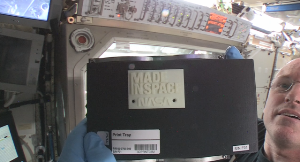A 3D printer on the International Space Station (ISS) has successfully created the first 3D printed object in space. The 3D Printing in Zero-G Technology Demonstration aims to show that additive manufacturing can be used to build a wide range of 3D printed tools and components in space.
The study was also conducted to check whether the 3D printing process functions the same in microgravity as it does on Earth. This is a significant breakthrough in space technology and opens the doors to future space expeditions.
 International Space Station Commander Barry “Butch” Wilmore holds up the first object made in space with additive manufacturing or 3-D printing. Wilmore installed the printer on Nov. 17, 2014, and helped crews on the ground with the first print on Nov. 25, 2014. Image Credit: NASA
International Space Station Commander Barry “Butch” Wilmore holds up the first object made in space with additive manufacturing or 3-D printing. Wilmore installed the printer on Nov. 17, 2014, and helped crews on the ground with the first print on Nov. 25, 2014. Image Credit: NASA
The 3D printer was installed by NASA astronaut Barry "Butch" Wilmore, who performed the first calibration test print. This first print paves the way for on-demand machine shop capabilities for long-duration space missions. According to Wilmore, the space station is a suitable platform where this technology can be tested.
Depending on the outcome of the test print results, commands were sent by the ground control team to print another calibration test on November 20, 2014. These tests demonstrated that the 3D printer is ready for operation.
In addition, ground controllers sent a command to the printer to make a faceplate of the casing, which showed that the printer is even capable of making its own replacement parts.
Using a novel additive manufacturing process, the printer heats a low-temperature plastic filament and then extrudes this filament one layer at a time to create the part specified in the design file, which has been sent to the machine.
Upon subsequent inspection, the part was attached quite strongly to the tray. This could mean layer adhesion is different in microgravity. This phenomenon will be explored in more depth when future parts are printed.
Space Station Live: Setting up a Machine Shop in Space
Eventually, a new print tray was installed and commands were sent to realign the printer and print a third calibration coupon. Once this calibration coupon is removed, the ground team will instruct the printer to create a second object. The results of the first print give a better insight about the parameters to be used when printing on the space station.
As the first objects are being printed, Made In Space engineers and NASA are monitoring the process through downlinked videos and images. The objects created in space will be brought back to Earth in 2015 and will be compared against similar ground control samples created on the flight printer. Final flight testing will be carried out at NASA’s Marshall Center before the launch.
"The operation of the 3D printer is a transformative moment in space development. We’ve built a machine that will provide us with research data needed to develop future 3D printers for the International Space Station and beyond, revolutionizing space manufacturing. This may change how we approach getting replacement tools and parts to the space station crew, allowing them to be less reliant on supply missions from Earth." Aaron Kemmer, chief executive officer of Made In Space.